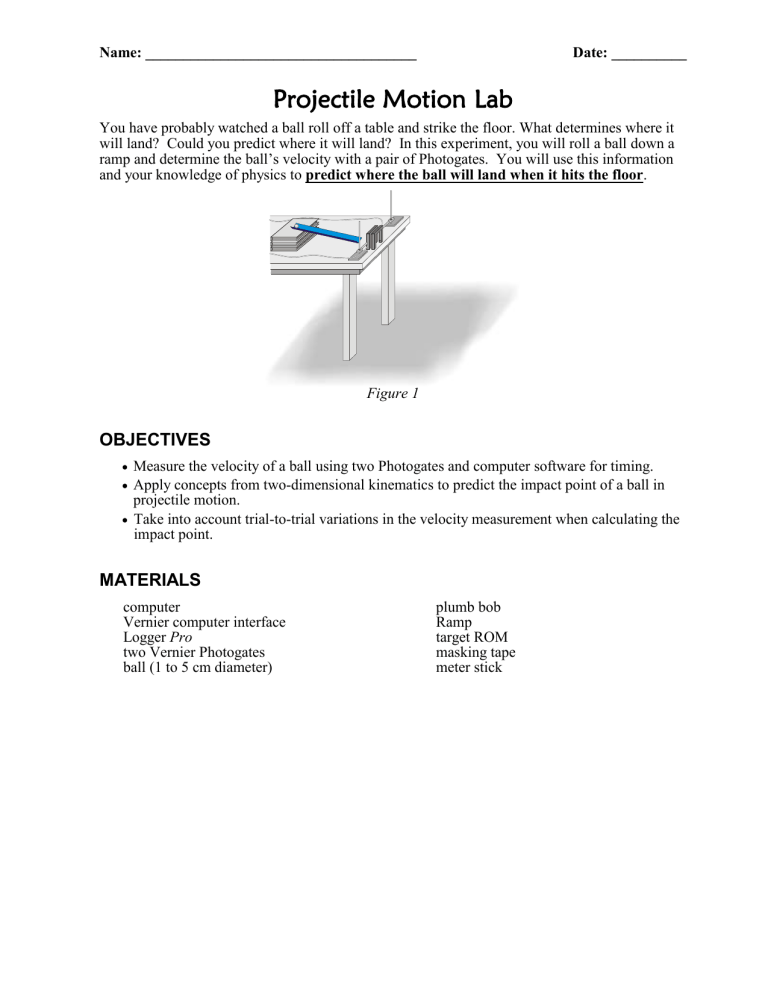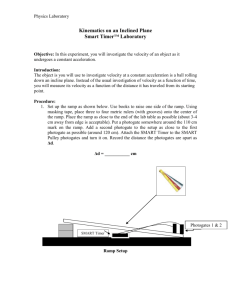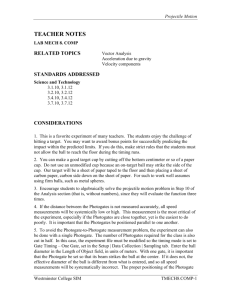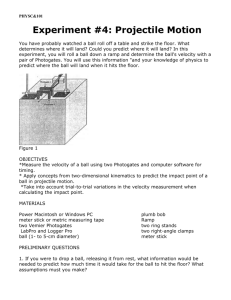Projectile Motion

Name: ____________________________________
Projectile Motion Lab
Date: __________
You have probably watched a ball roll off a table and strike the floor. What determines where it will land? Could you predict where it will land? In this experiment, you will roll a ball down a ramp and determine the ball’s velocity with a pair of Photogates. You will use this information and your knowledge of physics to predict where the ball will land when it hits the floor .
Figure 1
OBJECTIVES
Measure the velocity of a ball using two Photogates and computer software for timing.
Apply concepts from two-dimensional kinematics to predict the impact point of a ball in projectile motion.
Take into account trial-to-trial variations in the velocity measurement when calculating the impact point.
MATERIALS
computer
Vernier computer interface
Logger Pro two Vernier Photogates ball (1 to 5 cm diameter) plumb bob
Ramp target ROM masking tape meter stick
Projectile Motion Lab
PROCEDURE
1. Set up a low ramp made of a ruler on a table so that a ball can roll down the ramp, across a short section of table, and off the table edge as shown in Figure 1.
2. Position the Photogates so that the detection lines of the Photogates are exactly 10.0 cm apart . Also, position the Photogates so the ball rolls through each of the Photogates while rolling on the horizontal table surface (but not on the ramp). Connect Photogate 1 to
DIG/SONIC 1 of the interface and Photogate 2 to DIG/SONIC 2 . To prevent accidental movement of the Photogates, use masking tape to secure the Photogates in place.
3. Mark a starting position on the ramp with masking tape so that you can repeatedly roll the ball from the same place. Roll the ball down the ramp through each Photogate and off the table. Make sure that the ball does not strike the sides of the Photogates.
Note: Do not let the ball hit the floor. Catch the ball as soon as it leaves the table.
4. Go to: My Computer > Student Drive > Integrated Science folder. Double-click the file
“Projectile Motion Lab” to open Logger
Pro and begin the experiment. A data table and two graphs are displayed; one graph will show the time required for the ball to pass through the
Photogates for each trial and the other will display the velocity of the object for each trial.
5. Click . Check to see that the Photogates are responding properly by moving your finger through Photogate 1 and then Photogate 2. Logger Pro will plot a time interval (
t ) value for each instance you run your finger through Photogate 1 or Photogate 2. In the data table, Photogate 1 should have an “open” and “closed” reading before Photogate 2.
Call your teacher over to check that the Photogates are working properly .
6. Click , then click again, to clear the trial data and prepare for data collection.
Roll the ball from the mark on the ramp, through both Photogates, and catch the ball immediately after it leaves the table. Repeat nine times. Take care not to bump any of the
Photogates, or your velocity data will not be precise. Data collection will stop after two minutes. If you need more time, click trial, click
to restart, choosing Append. After the last
to end data collection. Record the velocity for each trial number in the data table.
7. Inspect your velocity data. Did you get the same value every time? Determine the average, value by clicking once on the velocity vs . time graph and then clicking the Statistics button,
. Record the average (mean) velocity in the data table.
8. Measure the distance from the table top to the floor and record it as the table height h in the data table. Use a plumb bob to locate the point on the floor just beneath the point where the ball will leave the table. Mark this point with tape; it will serve as your floor origin . plumb bob f loor origin
Figure 2
Projectile Motion Lab
9.
Use the measured height of the table to determine the time it takes the ball to land on the floor.
Since the time is determined by the vertical height, use the following equation for vertical motion. Show your work below.
y
v iy t
1
2 g t
2
Hint #1: The distance must be in meters.
Hint #2: Since the ball rolls horizontally off the table, the initial vertical velocity is zero.
Hint #3: Since the ball falls due to the force of gravity only, the vertical acceleration is the acceleration due to gravity, -9.8 m/s 2 .
10.
Use your average velocity value to calculate the distance from the floor origin to the impact point where the ball will hit the floor, using the equation below.
x
v x t
Hint #1: The time the ball takes to fall is the same as the time the ball flies horizontally.
Hint #2: Your calculated distance is in meters.
11.
Mark your predicted impact point on the floor with a target ROM at the predicted impact point.
Draw a line across the ROM at the predicted impact point. Be sure the impact point is along the line of the track.
12.
After your instructor gives you permission , release the ball from the marked starting point, and let the ball roll off the table and onto the floor. A dot should appear on ROM where the ball landed. Measure the distance from the floor origin to the actual impact point and enter the distance in the data table. IF YOU MISS THE ROM, your calculations are probably incorrect.
Recalculate and try again.
Projectile Motion Lab
DATA TABLE
Trial
5
6
7
8
1
2
3
4
9
10
Velocity
(m/s)
Average velocity
Table height
Predicted impact point
Actual impact point distance
ANALYSIS
1. Did the ball land farther from or closer to the table than your predicted position?
2. You were not able to account for air resistance in your prediction. If air resistance were not present, would the ball land farther from or closer to the table? Why?
3. Does your observation of the ball’s actual landing point make sense when you consider the effect of air resistance? Why or why not?
4. Find the % error between the predicted and actual impact distances.
% error
actual
predicted actual x 100 m m/s m m









